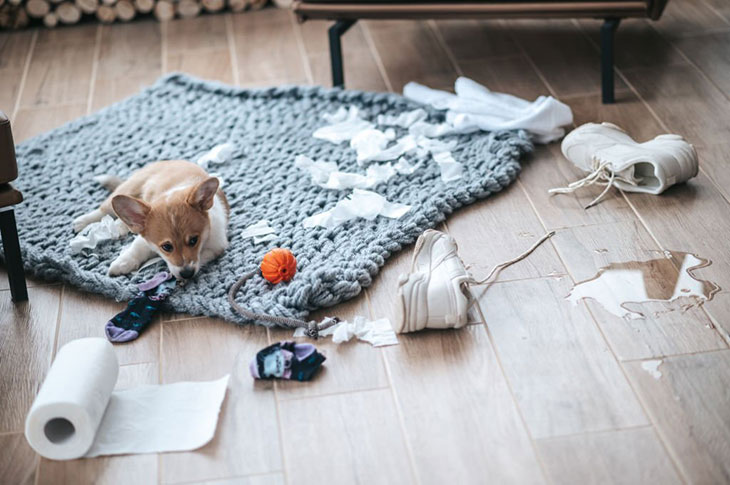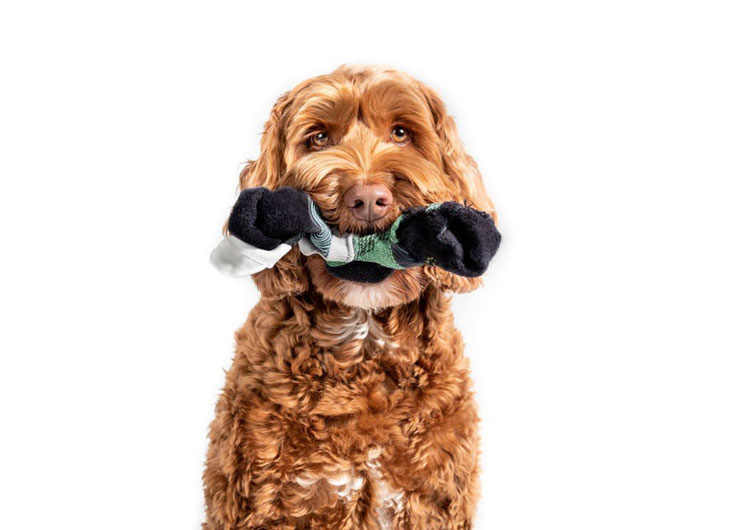What if my dog ate a sock but is acting normal? As you’re a dog owner, you know how curious and mischievous our furry friends can be.
They tend to put just about anything in their mouths, from shoes to socks and sometimes even non-food items like rocks or toys.
While some of these cloth items may pass through their digestive system without causing any harm, others can lead to serious and even life-threatening complications.
When this happens, you may be wondering what to do next. Even if your dog seems to be acting normal, taking appropriate steps to ensure their health and well-being is important.
Why Dogs Eat Socks

While it may seem amusing to see your furry friend running around with a sock in their mouth, this behavior can harm their health.
Let’s say your dog ate sock 3 days ago. Here are some reasons they did it, including their owner’s scent, boredom, pica, and other reasons.
Owner’s Scent
One reason why dogs may eat socks is that they are attracted to their owner’s scent.
Dogs have an incredibly strong sense of smell and use it to identify and familiarize themselves with their surroundings.
If your dog is anxious or stressed, it may seek comfort by chewing on an item that smells like its owner.
Socks are a popular target because they are often left lying around the house and are likely to have your scent on them.
Boredom
Dogs are active creatures that require mental and physical stimulation to stay happy and healthy.
If they do not receive enough attention or exercise, they may resort to destructive behaviors like chewing on household items, including socks.
When you suspect that your dog is bored, try increasing their exercise routine, playing games with them, and providing them with interactive toys to keep their minds stimulated.
This could also be the behavior you see in puppies. If your 9-month-old puppy is constantly chewing non-food items, you can check out this guide.
Pica
Pica is a condition in which dogs crave non-food items, including socks. This condition is more commonly seen in puppies and young dogs, but it can also occur in adult dogs.
Pica can be caused by a number of factors, including nutrient deficiencies, gastrointestinal disorders, and anxiety.
If you suspect that your dog has pica, it is important to consult with your veterinarian to rule out any underlying medical conditions and to provide appropriate treatment.
Other Reasons
There may be other reasons why dogs eat socks that are not related to the things above. For example, my dog used to enjoy the texture and taste of socks.
Others may be attracted to the smell of laundry detergent or fabric softener used to wash socks.
Additionally, some dogs may have an obsessive-compulsive disorder that causes them to engage in repetitive behaviors, such as chewing on socks.
What If My Dog Ate A Sock But Is Acting Normal?
Every dog is unique, and your dog’s reaction to ingesting something that isn’t food will probably be just as special.
Your dog might consume anything that isn’t food and not show symptoms because it will likely be thrown up soon after.
It’s also crucial to remember that although they might act normally right away after the incident, that behavior might not last. The digestive tract takes a while to process non-food substances.
Because they can’t be easily broken down, non-food objects can take longer to pass through your pet’s digestive system.
A few weeks, according to some veterinarians, may pass before a sock passes through the digestive system.
While your dog is functioning normally, it could display more alarming symptoms a few hours or days from now.
Therefore, it is essential to keep an eye on your pet following the incident in case they start acting strangely.
Since most dogs often chew on things other than food without being hurt, there might not be a concern when your pet doesn’t exhibit any symptoms.
Due to their larger internal organs and simpler passage, larger dogs typically have little problem ingesting objects like socks.
If your dog is very little, obstructions may provide a greater concern, and your pet faces greater risk when eating non-food items.
Possible Risks Your Dog Faces After Swallowed A Sock

Some pets are attracted to socks and other non-food items. This can be dangerous for your furry friend as socks are not easily digestible and can cause blockages in their digestive system.
Suppose your dog ate sock 5 days ago; the possible risks include obstruction of the digestive system, choking, and the potential for infection.
Obstruction Of The Digestive System
Socks, like many other non-food items, are not meant to be ingested and can cause blockages in your dog’s gastrointestinal tract.
This can lead to serious health problems, including vomiting, diarrhea, abdominal pain, and even damage to the intestines.
When the blockage is not treated promptly, it can be life-threatening for your furry friend. That’s why monitoring your dog’s behavior closely and seeking veterinary care immediately is essential.
Risk Of Choking
If the sock is too large or gets stuck in your dog’s throat, it can cause choking. Socks are not only small enough to become lodged in your dog’s throat.
Still, they can also become tangled in their intestines or stomach, creating a blockage that prevents food and water from passing through.
This can be a life-threatening emergency that requires immediate attention. Signs of choking include difficulty breathing, gagging, coughing, and pawing at the mouth.
Infection
When foreign objects such as socks become lodged in your dog’s digestive tract, they can cause irritation and inflammation.
This can lead to the development of infections such as gastritis or gastroenteritis, which can cause constant vomiting, diarrhea, abdominal pain, and loss of appetite.
Suppose the sock causes damage to your dog’s intestines; it can also lead to the development of peritonitis, a potentially life-threatening infection of the lining of the abdominal cavity.
Signs of infection include fever, lethargy, loss of appetite, and severe vomiting.
What You Should Do When Your Dog Ate A Sock
There shouldn’t be a problem if you catch your dog throwing up right away and discover the entire sock contents.
Dogs frequently ingest objects that aren’t food and then throw them up. You should monitor their bowel motions since the sock may be passed that way when they did not vomit it up.
For the majority of dogs, it could take a couple of days (around 2 to 3 days), but for a few, it could take a week or longer.
The digestive tract may occasionally take longer to process heavier materials like garments. You should speak with your veterinarian for their advice because this is also particular to each dog and breed.
Suppose the necessary amount of time has passed, and your dog still hasn’t thrown up any of the contents of the sock.
In this case, you should visit the veterinarian, as the problem can be more serious than you thought.
Veterinary Strategies To Treat Your Dog
When you arrive at the veterinarian’s clinic, the staff will check your dog’s vitals and obtain a history document.
They will inquire about the incident, the overall health of your dog, and, of course, the sock. For instance, a sock could require different cleaning techniques than a tennis sock made of cotton.
After that, your veterinarian will perform a physical examination, including a visual check of the throat and mouth.
Additionally, your dog’s abdomen will be palpated to determine whether it is rigid or in pain.
The sock’s location will typically be determined via X-rays. Let’s say it hasn’t entered the digestive tract very far.
Your veterinarian may be able to see it with an endoscope, which is a long, flexible camera that is inserted down your dog’s throat.
The vet’s staff will then treat your dog according to the symptoms, apparent distress level, and the sock’s position.
They could advise you to wait it out in the hopes that it would go away on its own when the item is small and your furry friend is huge.
They may also induce vomiting dog ate sock in the hopes that the animal would just throw up the object.
Signs Of Health Issues You Should Pay Attention To
Some common signs of illness may indicate your dog has eaten a sock.
- Vomiting
- Diarrhea
- Abdominal pain or discomfort
- Loss of appetite
- Lethargy
- Difficulty passing stool
- Signs of choking or gagging
- Straining to defecate
- Blood in the stool
- Restlessness or discomfort
- Difficulty breathing
If you notice any of these signs, it’s important to contact your veterinarian right away.
Swift action can help prevent serious health issues from developing and can ensure that your dog receives prompt and effective treatment.
How To Prevent This From Happening Again

Although dogs will always be dogs, sensible dog owners should take certain precautions to help avoid accidents. Below are some tips to help prevent this trouble from happening.
- Keep socks and other small objects out of your dog’s reach, especially when you’re not around to supervise.
- Provide your dog with plenty of appropriate toys and chews to satisfy their chewing needs.
- Consider crate training your dog or using baby gates to limit their access to certain areas of your home.
- Provide your dog with plenty of mental and physical stimulation, such as daily walks and playtime.
- Train your dog to “leave it” and “drop it” to discourage them from picking up and chewing on inappropriate objects.
- Keep your home tidy and free of clutter to reduce the likelihood of your dog finding and chewing on socks or other things.
- Consider using bitter-tasting sprays or deterrents on strange objects that your dog is prone to chewing on.
Frequently Asked Questions
How Long Will It Take My Dog To Pass A Sock?
The time it takes for a dog to pass a sock can vary, and there is no definitive answer. It depends on several factors, such as the size of the dog, the size of the sock, and the dog’s digestive system.
Can A Dog’s Stomach Acid Dissolve A Sock?
No, a dog’s stomach acid cannot dissolve a sock. Socks are made of materials that are not easily digestible and can cause blockages in a dog’s digestive system, which can be life-threatening.
How Long Can A Dog Survive With A Blockage?
The survival time of a dog with a blockage depends on several factors, such as the location and severity of the blockage, the age and health of the dog, and how quickly it is diagnosed and treated.
In general, a dog can survive 3 days to a week with a blockage, but without prompt medical attention, it can lead to severe complications and even death.
The Bottom Line
Suppose your dog has eaten a sock but is acting normal; it’s important to stay vigilant and monitor their behavior closely.
While the sock may pass through their digestive system without causing any harm, it’s important to take appropriate steps to ensure their health and well-being.
When your pet eats non-edible items such as socks, a part of a blanket, etc., contact your veterinarian right away.
Also, keep an eye on your dog’s behavior, and take preventative measures to avoid future incidents. This can all help keep your furry friend safe and healthy.
Remember, prevention is key when it comes to your dog ingesting foreign objects, so be sure to keep any tempting items out of reach and address any underlying behavior issues with the help of a professional.
